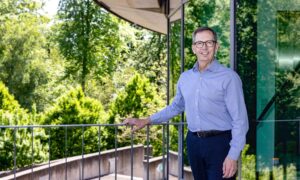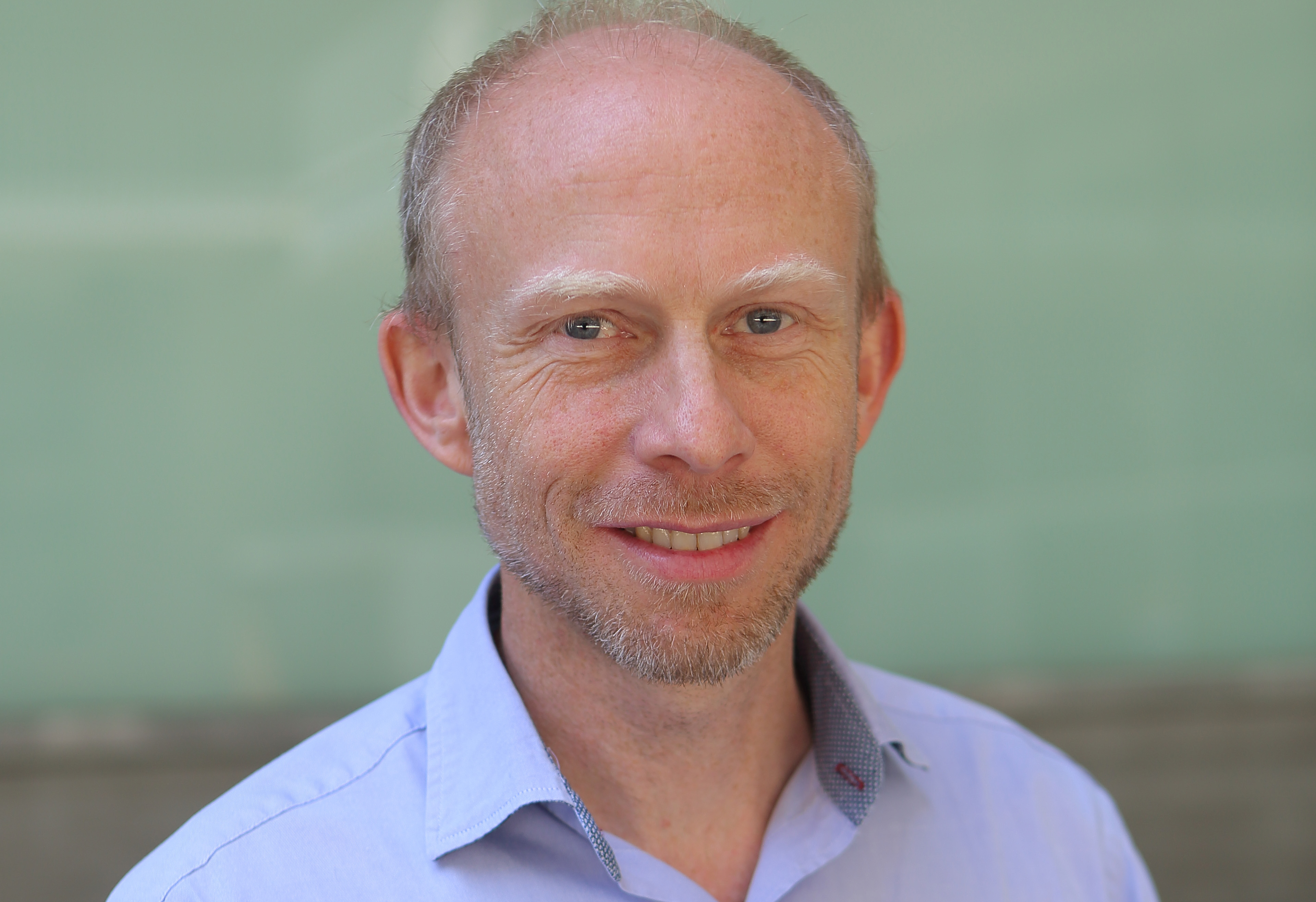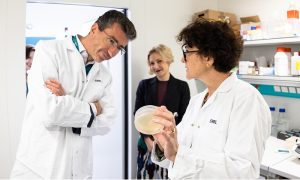
Welcome: James Sharpe
As EMBL opens its sixth site in Spain, get to know to the new Head of EMBL Barcelona, James Sharpe

The focus of EMBL Barcelona is tissue biology and disease modelling. What excites you about this field of research?
Scientists have been phenomenally successful at developing an understanding of how biology works at the molecular and cellular levels. But we are now reaching the point where we can begin to understand how tissues work beyond the level of individual cells. At a higher scale, where the interactions of thousands of cells control many different important processes, we can explore things such as how organs develop, how tissues maintain their healthy structure during adult life, how regeneration works in some species, how tumours grow and even how tissue dynamics is important for the immune system. We’re at a very exciting phase when we’re starting to understand these higher-level phenomena, and how and why some of these processes go wrong in disease.
In recent years a number of new technologies make possible what was inconceivable just a decade ago. First, new 3D imaging technologies allow us to observe the structure and dynamics of large multi-cellular tissues. Second, new high-speed computers allow us to model the complex dynamics of thousands of interacting cells. And third, new in vitro culture techniques have advanced to the point where researchers can produce three-dimensional tissue structures from human cells in the laboratory that resemble those found in organs such as the eye, gut, liver and breast. Small but complex tissues that mimic some of the structure and function of real organs – known as organoids – together with other exciting new tissue related approaches, are enhancing our understanding of human biology, providing disease models and drug-screening possibilities directly in human tissue. It is an incredibly exciting time, and while there is a long journey ahead, we are going to learn an awful lot of human biology along the way.
The underlying question is: if we can understand how tissues grow, build, fix and maintain themselves, can we control them enough to build the things we want? Doing so raises the prospect of being able to make and heal organs and tissues as well as develop treatments for certain types of cancer, diseases of the immune system and birth defects, which can involve flaws in how cells arrange and interact at the tissue level.
The underlying question is: can we control tissues enough to build the things we want?
What are the main goals for EMBL Barcelona?
A key goal is to become a centre of reference in this field, and to host groups making major breakthroughs in our understanding and treatment of tissue-related diseases, through technologies such as human organoids and others.
I believe we also have the opportunity to help define the field of tissue biology. Having been originally trained as a developmental biologist, I know that a lot of our knowledge about multicellular tissue interactions has come from that field. But a lot more is still to be learned, and it’s not relevant only to embryo development. So many adult tissues show complex dynamic behaviour – both in normal and disease states: tissue homeostasis, tumour growth, and many more – and these processes are not always understandable by only focusing at the cellular or molecular level. New principles, ideas and questions emerge at the tissue level, such as positional information, multi-scale feedback control and self-organisation. I believe this collection of concepts, along with exciting new technologies, means that tissue biology – or multicellular systems biology – should be seen as an emerging field in its own right. It is an area that integrates ideas and data from many other areas of biology, including bioinformatics, genetics and cell biology.
For the research community in Barcelona, one clear benefit will be having stronger links and more direct interactions with the EMBL family. We will be hiring seven new groups, bringing in experts from all over the world – an injection of talent that will complement the already strong local research community. EMBL will benefit from being a part of the strong and exciting research community in the Barcelona Biomedical Research Park (PRBB). Through partnership, EMBL has built a terrific relationship with the Centre for Genomic Regulation (CRG) over the past 10 years. Creating an EMBL site here is a natural next step.
How will you get started?
To begin with, I am taking a three-month sabbatical hosted at the Massachusetts Institute of Technology in Boston. I will be learning more about the latest developments in areas such as tissue engineering, organ-on-chip technologies, microfluidics and organoids – all areas that are relevant and important to EMBL Barcelona.
Next we will look at bringing people from new areas of research into the EMBL community, such as in tissue mechanics, tissue reactors and bioprinting. Firstly, over this summer, we will put out call for Head of EMBL Barcelona’s Mesoscopic Imaging Core Facility – this will provide researchers access to technologies including Optical Projection Tomography and Selective Plane Illumination Microscopy. Shortly afterwards we will advertise for our first junior group leaders. There will be ongoing recruitment of scientists and support staff over the first couple of years – ultimately we will host seven research groups, in addition to the core facility, which will also pursue technology research in imaging and modeling.

What sort of people are you looking for?
One of the great strengths of the EMBL-CRG Systems Biology programme has been that every group combines experimental laboratory work with serious computational biology. I have seen first-hand the power of this approach, and although it’s sometimes challenging to get biologists and physicists to speak to the same language, it is one of the key ingredients to understand very complex biology. Experience of such interdisciplinary work will be especially valuable.
In five years time we be starting to make breakthroughs in our understanding of tissues and tissue-related diseases
How did you get into science?
When I was 10 years old, my dad bought us one of the first computers – a Sharp MZ-80K. It didn’t have any games – all you could do was program it! I got hooked on the amazing promise of coding – the idea that you could program anything you could dream-up – that in effect you were only limited by your imagination. That also led me into designing and building simple digital electronic circuits – I was a real nerd! When I later started learning about molecular biology, these two nerdy hobbies helped me to see the fascinating parallels between computing and the way our bodies use and process information: computer code versus the genetic code. I was determined to learn more – to see how biology could be understood as a control system based on gene circuits, with possible parallels with electronic circuits.
Can you recall one of your greatest successes?
One of the biggest highlights of my career so far was the development of optical projection tomography. My degree and PhD were strongly focused on experimental molecular biology, but for my postdoc at the MRC Human Genetics Institute in Edinburgh I had decided to try to write the first integrated computer simulation of limb development. But after two years I hit a brick wall – I discovered that the real problem wasn’t so much the challenge of writing the computer model, but rather the complete lack of good 3D data. My nerdy childhood with programming and electronics paid off again, as I started tinkering with building a homemade computer-controlled system that would carefully spin a sample of tissue in a place where it could be imaged by a microscope. The idea was that by acquiring images of the sample from many different projection angles, I could then use tomographic reconstruction algorithms like those used in X-ray CT, to calculate cross-sectional images. Building my prototype involved improvising, such as ransacking an old FACS machine that had been lying in the corridor for a few years! After six months, I had something working really well. Luckily, like EMBL, the HGU still had a proper mechanical workshop and in the next phase we were able to build things more professionally.
Ultimately we will host seven research groups, in addition to a core facility
Where will EMBL Barcelona be in five years?
Within five years, I hope we will have brought together a group of inspiring and innovative people from many different backgrounds, united by a curiosity of how tissues and organs organise and develop – going beyond the level of individual cells, to where the questions are intrinsically about the interactions of large numbers of cells. The researchers will be starting to make breakthroughs in our understanding of tissues and tissue-related diseases. Tissue biology is a field that is still not widely-recognised or well defined, and we will help define it.


